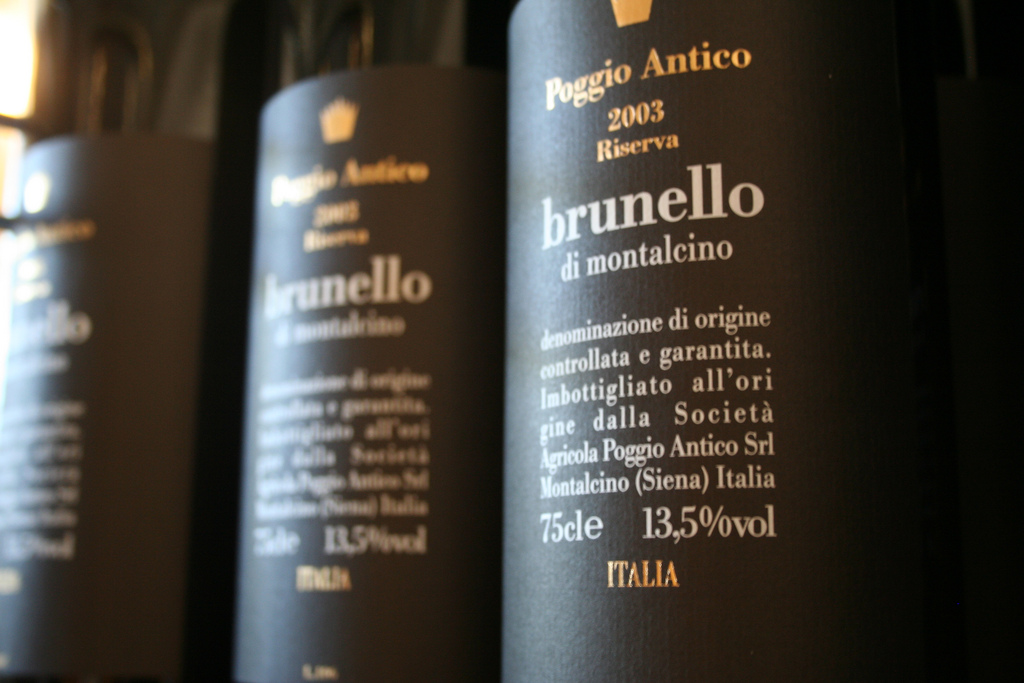Did you know that wine from Montalcino (the name Brunello was invented much later) was first served at Buckingham Palace in 1696? And that it boasts many firsts in Italy, including the first Italian wine scandal? Perhaps, like most people, you don’t. Which is why it is worth making the trip to the newly reopened Museo del Brunello in the Fattoria dei Barbi, just outside Montalcino. There, you can learn the history of this precious drink in both English and Italian, including the juicy scandal when, in 1472, all of Bishop Piccolomini’s grapes were seized because he had not respected the start date for harvest. Besides history, you will also discover how this finest of Italian wines is made today, and how vintages can obtain the Brunello di Montalcino label.

Brunello di Montalcino | Photo by Megan Cole on Flickr
The full name of the museum is quite a mouthful: Museo del Brunello e della Comunità di Montalcino. This is because, besides delving into the depths of Montalcino wine, the museum also has a section focused on the traditional crafts of the area, with plenty of nostalgic black-and-white photos and some rather mysterious-looking tools.
Despite its bureaucratic-sounding name, the museum is privately owned. The owner is Stefano Cinelli Colombini, who inherited the Fattoria dei Barbi, which his ancestors bought in 1790, and who created the museum from scratch. It ran for three years (2007–2010), then closed for another three, and reopened in March 2013 under new management, BG Events, which is planning to infuse new life into the place with art exhibits, book presentations, and perhaps even music and film, creating what they call ‘lo spazio possibile,’ a place where everything is possible.
Until the end of August, contemporary artist Emma Salvati is exploring the ‘possible space’ with an exhibit called Sogni e Visioni del mio TempoArte. Salvati’s paintings portray a positive, sparkling attitude to life. They burst with bright hues: pinks, greens, blues, yellows, oranges. They uplift you with their freshness and optimism. Sometimes they are figurative; other times abstract; often three-dimensional, with buttons, fairies and borders protruding and reaching out to the viewer (Salvati calls them her ‘hanging sculptures’). Some of her paintings deal with grave subjects: migration, exploding inner certainties, voices warning against following one’s heart. Other paintings simply celebrate the joys of life: the magic of the Val d’Orcia, with fairies sitting on bright green valleys, or the vigor of contemporary art, represented by champagne bursting out of a newly opened bottle.
What, you may ask, do wine and art have in common? Why show paintings in a wine museum? According to Salvati, ‘Wine is art.’ She explains that in the past, landowners were proud of the quality of their land. But they could not cut off pieces of land to send it to others and show off. So they would send things produced by their land, to represent it. Fruits and vegetables were perishable. Wine, instead, was easy to transport and to export, and thus the quality of wine came to represent the quality of the land. In this sense, wine is like a work of art: a symbol, a representation of something else.
After all, an exhibit in a place like the Brunello museum is a great way to spread contemporary art. Not in a dusty gallery where only the connoisseurs go, but in a place the whole family can enjoy that joins wine and sparkling art in ‘lo spazio possibile.’
Museo del Brunello e della Comunità di Montalcino
Fattoria dei Barbi, Loc. Podernovi 170, Montalcino (SI)




